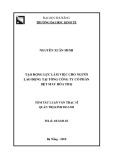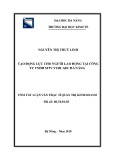
ON BOUNDARY VALUE PROBLEMS FOR SECOND-ORDER
DISCRETE INCLUSIONS
PETR STEHL´
IK AND CHRISTOPHER C. TISDELL
Received 8 October 2004
We prove some existence theorems regarding solutions to boundary value problems for
systems of second-order discrete inclusions. For a certain class of right-hand sides, we
present some lemmas showing that all solutions to discrete second-order inclusions sat-
isfy an aprioribound. Then we apply these aprioribounds, in conjunction with an ap-
propriate fixed point theorem for inclusions, to obtain the existence of solutions. The
theory is highlighted with several examples.
1. Introduction
The theory of differential inclusions has received much attention due to its versatility and
generality. For example, differential inclusions can accurately model discontinuous pro-
cesses, such as systems with dry friction; the work of an electric oscillator; and autopilot
(and other) control systems [8]. When considering these (or other) situations in discrete
time, the modeling process gives rise to a discrete (or difference) inclusion, rather than a
differential inclusion. In many cases, considering the model in discrete time gives a more
precise or realistic description [1].
Let Xand Ybe two normed spaces. A set-valued map G:X→Yis a map that associates
with any x∈XasetG(x)⊂Y.ByCK(E), we denote the set of nonempty, convex, and
closedsubsetsofaBanachspaceE.WesaythatG:Rn→CK(Rn)isupper semicontinuous
if for all sequences {ui}⊆Rn,{vi}⊆Rn,wherei∈N, the conditions ui→u0,vi→v0,and
vi∈G(ui)implythatv0∈G(u0). Since the upper semicontinuity plays an essential role
in this paper, we illustrate this notion by the simple example [5, Example 4.1.1].
Example 1.1. The set-valued map f1:R→Rdefined by
f1(t)=
{0}for t=0,
[0,1] for t∈R\{0},(1.1)
is not upper semicontinuous. On the other hand, the set-valued map f2:R→Rdefined
Copyright ©2005 Hindawi Publishing Corporation
Boundary Value Problems 2005:2 (2005) 153–163
DOI: 10.1155/BVP.2005.153

154 On BVP for second-order discrete inclusions
by
f2(t)=
[0,1] for t=0,
{0}for t∈R\{0},(1.2)
is upper semicontinuous.
For more information about set-valued maps and differential inclusions, see Aubin
and Cellina [3], Smirnov [8], or Erbe, Ma and Tisdell [6].
We are interested in the following boundary value problem (BVP) for second-order
discrete inclusions:
∆2y(k−1) ∈Fk,y(k),∆y(k),k=1,...,T,y(0) =A,y(T+1)=B,(1.3)
where A,B∈Rdare constants and F:{1,...,T}×Rd×Rd→CK(Rd)isaset-valued
map. A solution ¯
y={y(k)}T+1
k=0∈R(T+2)dto (1.3)isavector ¯
y={y(0), ...,y(T+1)}such
that each element y(k)∈Rdsatisfies the discrete inclusion for k=1,...,Tand the bound-
ary conditions for k=0andk=T+1.
In Section 2, we show that under certain conditions on the right-hand side F,allso-
lutions of (1.3) are bounded. The inequalities employed rely on growth conditions on F
and on appropriate discrete maximum principles.
Section 3 contains the appropriate operator formulations for (1.3) to be considered as
a fixed point problem.
In Section 4, we apply the results of Sections 2and 3to prove the existence of solutions
to (1.3), in conjunction with the following fixed-point theorem [2, Theorem 1.2].
Theorem 1.2. Let Ebe a Banach space, Uan open subset of E,and0∈U.Supposethat
P:U→CK(E)is an upper semicontinuous and compact map. Then either
(A1) Phas a fixed point in U,or
(A2) there exist u∈∂U and λ∈(0,1) with u∈λP(u).
To prove the compactness of the image of an upper semicontinuous map, we will use
a criterion which can be found in Berge [4,th
´
eor`
eme VI.3].
Theorem 1.3. Let P:X→Ybe an upper semicontinuous map. If Kis a compact set in X,
then P(K)is a compact set in Y.
In [2], Agarwal et al. gave conditions under which the following BVP has at least one
solution:
∆2y(k−1) ∈Fk,y(k),k=1,...,T,y(0) =0, y(T+1)=0, (1.4)
where F:{1,...,T}×R→CK(R). In comparison with the results and conditions in [2],
we introduce new inequalities unrelated to those in [2] and we also extend some of the
results in [2].

P. S t e h l ´
ık and C. C. Tisdell 155
2. A priori bound
In this section, we prove two different aprioribound results for the following system of
BVPs for second-order discrete inclusions:
∆2y(k−1) ∈λFk,y(k),∆y(k),k=1, ...,T,y(0) =λA,y(T+1)=λB,
(2.1)
where λ∈[0,1].
The study of the above family of BVPs is motivated by the family of inclusions in
Theorem 1.2,u∈λP(u).
We denote ·,· as the Euclidean inner product and by · the Euclidean norm on
Rn.
Lemma 2.1. Let F:{1,...,T}×Rd×Rd→CK(Rd)be a set-valued map. If there exist con-
stants α≥0and K≥0such that
φ≤α2p,φ+q2+K,for k=1,...,Tand all (p,q)∈R2d,φ∈F(k,p,q),
(2.2)
then all solutions ¯
yofBVPforthesystemofdiscreteinclusions(
2.1)satisfy
y(k)
<R,k=0,...,T+ 1, (2.3)
for λ∈[0,1],andRis defined by
R:=αβ2+β+K(T+1)
2
8+1, β:=maxA,B.(2.4)
Proof. We suppose that ¯
yis a solution of (2.1). Since we work on a discrete topology,
every solution of (2.1) is a solution of a system of discrete BVPs,
∆2y(k−1) =λ
fk,y(k),∆y(k),k=1,...,T,y(0) =λA,y(T+1)=λB,
(2.5)
where
f:{1,...,T}×Rd×Rd→CK(Rd) is a single-valued function such that
f(k,p,q)∈
F(k,p,q)foreveryk=1,...,Tand (p,q)∈R2d. In the theory of the set-valued map,
fis
called a selector of F.
Then ¯
ysolves the summation equation
y(k)=λΦ(k)+λ
T
l=1
G(k,l)
fl,y(l),∆y(l),k=0,...,T+ 1, (2.6)
where
λΦ(k)=λA(T+1)+(B−A)k
T+1 , (2.7)

156 On BVP for second-order discrete inclusions
and G:{0,...,T+1}×{1,...,T}→Rddefined by
G(k,l)=
−1
T+1l(T+1−k), l=1, ...,k−1,
−1
T+1k(T+1−l), l=k,...,T,
(2.8)
is Green’s function for the BVP,
∆2y(k−1) =0, k=1,...,T,y(0) =0, y(T+1)=0.(2.9)
Since λΦ(k)≤βfor each k=0,...,T+1,weobtainthat
y(k)
≤β+
T
l=1
G(k,l)
λ
fl,y(l),∆y(l)
.(2.10)
Using (2.2), we have that
y(k)
≤β+
T
l=1
G(k,l)
λα2y(l),
fl,y(l),∆y(l)+
∆y(l)
2+K
≤β+
T
l=1
G(k,l)
α2y(l),λ
fl,y(l),∆y(l)+
∆y(l)
2+K.
(2.11)
Define
r(k):=
y(k)
2,k=0,...,T+ 1, (2.12)
and use the discrete product rule to calculate the second difference of rat the point k−1
to obtain
∆2r(k−1) =
∆y(k)
2+2
y(k),∆2y(k−1)+
∆y(k−1)
2.(2.13)
By using the first equation in (2.5), we deduce that
∆2r(k−1) ≥
∆y(k)
2+2
y(k),λ
fk,y(k),∆y(k).(2.14)
We install this into (2.11)toobtainthat
y(k)
≤β+α
T
l=1
G(k,l)
∆2r(l−1) +
T
l=1
G(k,l)
K. (2.15)

P. S t e h l ´
ık and C. C. Tisdell 157
Using (2.8) we make the following computations:
T
l=1
G(k,l)
∆2r(l−1) =T+1−k
T+1
k−1
l=1
l∆2r(l−1) + k
T+1
T
l=k
(T+1−l)∆2r(l−1)
=T+1−k
T+1 l∆r(l−1)k
1−
k−1
l=1
∆r(l)
+k
T+1(T+1−l)∆r(l−1)T+1
k+
T
l=k
∆r(l)
=T+1−k
T+1 k∆r(k−1) −∆r(0) −r(k)+r(1)
+k
T+1−(T+1−k)∆r(k−1) + r(T+1)−r(k)
=T+1−k
T+1 r(0) + k
T+1r(T+1)−r(k)≤β2.
(2.16)
Finally, if we consider this estimation and (see, e.g., [7, Exercise 6.20])
max
k∈{0,...,T+1}
T
l=1
G(k,l)
≤(T+1)
2
8, (2.17)
we rewrite (2.15)as
y(k)
≤β+αβ2+K(T+1)
2
8<R,k=0,...,T+ 1, (2.18)
and this concludes the proof.
Definition 2.2. Let R>0 be a constant. Define the set DR⊂{1, ...,T}×Rd×Rdby the
set containing all triplets (k,p,q)suchthat
k=1,...,T,(p,q)∈R2d:p≥R,2p,q+q2≤0.(2.19)
By using the same selector technique as above, but employing an unrelated inequality,
we now prove the second aprioribound result.
Lemma 2.3. Let R>0be a constant such that
maxA,B<R, (2.20)
and let F:{1,...,T}×Rd×Rd→CK(Rd)be a set-valued map. If
2p,φ+q2>0, for every (k,p,q)∈DRand all φ∈F(k,p,q), (2.21)
then all solutions ¯
yfor the system of discrete inclusions (2.1)satisfy
y(k)
<R,k=0,...,T+ 1, (2.22)
for λ∈[0,1].








![Hình ảnh học bệnh não mạch máu nhỏ: Báo cáo [Năm]](https://cdn.tailieu.vn/images/document/thumbnail/2024/20240705/sanhobien01/135x160/1985290001.jpg)

















